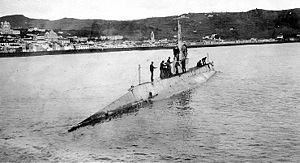USS K-6
 Stern view of the K-6 (SS-37) at Horta, Fayal, Azores, in December 1917
| |
| History | |
|---|---|
| Name | K-6 |
| Builder | Fore River Shipyard, Quincy, Massachusetts |
| Laid down | 19 June 1912 |
| Launched | 26 March 1914 |
| Commissioned | 9 September 1914 |
| Decommissioned | 21 May 1923 |
| Reclassified | SS-37, 17 July 1920 |
| Stricken | 18 December 1930 |
| Fate | Sold for scrapping, 3 June 1931 |
| General characteristics | |
| Type | K-class submarine |
| Displacement |
|
| Length | 153 ft 7 in (46.81 m) |
| Beam | 16 ft 8 in (5.08 m) |
| Draft | 13 ft 1 in (3.99 m) |
| Propulsion | Diesel-electric |
| Speed |
|
| Complement | 28 officers and men |
| Armament | 4 × 18-inch (450 mm) torpedo tubes |
USS K-6 (SS-37) was a K-class submarine of the United States Navy. Her keel was laid down by the Fore River Shipbuilding Company in Quincy, Massachusetts, under a subcontract from the Electric Boat Company of Groton, Connecticut. She was launched on 26 March 1914, sponsored by Mrs. Thomas Gaines Roberts, and commissioned on 9 September at Boston, Massachusetts.
Service history
[edit]Steaming to Newport, Rhode Island, on 16 November, K-6 joined the 4th Division, Atlantic Torpedo Flotilla, for shakedown and training. For almost three years, she conducted experimental and development operations along the Atlantic coast and in the Gulf of Mexico. She underwent diving tests off Cape Cod and Long Island, practiced firing torpedoes in Chesapeake Bay; and participated in tactical submarine exercises out of New London, Connecticut, Key West, Florida, and Pensacola, Florida. Following overhaul at Philadelphia, Pennsylvania, she departed New London on 12 October 1917, and steamed via Halifax, Nova Scotia, for patrol duty in the Azores.
K-6 arrived Ponta Delgada, Azores, on 27 October in company with three other K-class submarines. For more than a year they patrolled the surrounding ocean, searching for U-boats and surface raiders and preventing them from using the islands as a haven. After the surrender of Germany, K-6 sailed for the United States on 21 November arriving Philadelphia via Bermuda on 13 December. After overhaul, K-6 proceeded to New London on 28 May 1919, to resume development and tactical operations along the New England coast.
During the four years of service that followed, K-6 ranged the Atlantic from New England to the Caribbean Sea. Operating primarily out of New London, Hampton Roads, and Key West, she trained prospective submariners, conducted experimental dives and underwater maneuvers and proved the value of submarines as an effective part of the Navy. Arriving Hampton Roads from New London 21 March 1923, K-6 decommissioned on 21 May. Subsequently, she was towed to Philadelphia on 13 November 1924. Her name was struck from the Naval Vessel Register on 18 December 1930. She was broken up and sold for scrapping on 3 June 1931.
Notes
[edit]References
[edit]- Friedman, Norman (1995). U.S. Submarines Through 1945: An Illustrated Design History. Annapolis, Maryland: Naval Institute Press. ISBN 1-55750-263-3.
- Gardiner, Robert & Gray, Randal, eds. (1985). Conway's All the World's Fighting Ships 1906–1921. Annapolis, Maryland: Naval Institute Press. ISBN 0-85177-245-5.
 This article incorporates text from the public domain Dictionary of American Naval Fighting Ships. The entry can be found here.
This article incorporates text from the public domain Dictionary of American Naval Fighting Ships. The entry can be found here.
External links
[edit]- Photo gallery of USS K-6 at NavSource Naval History
